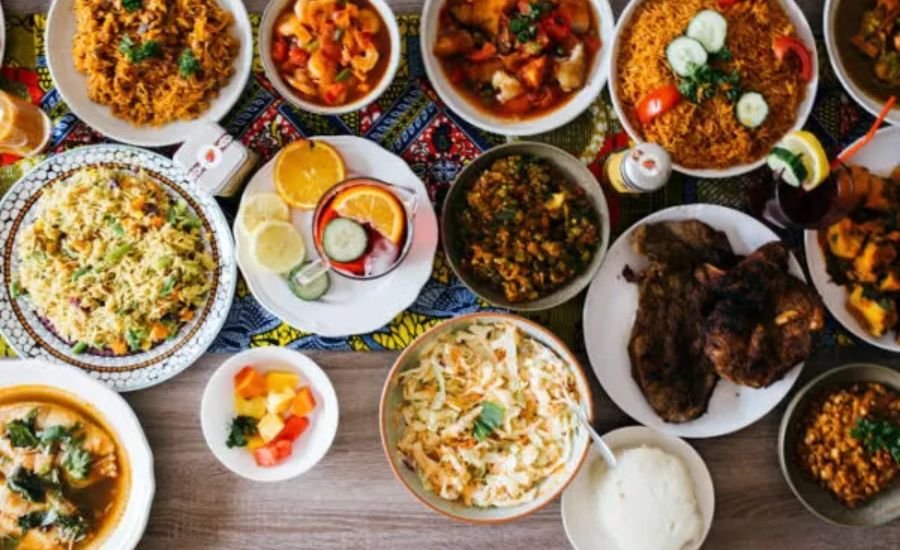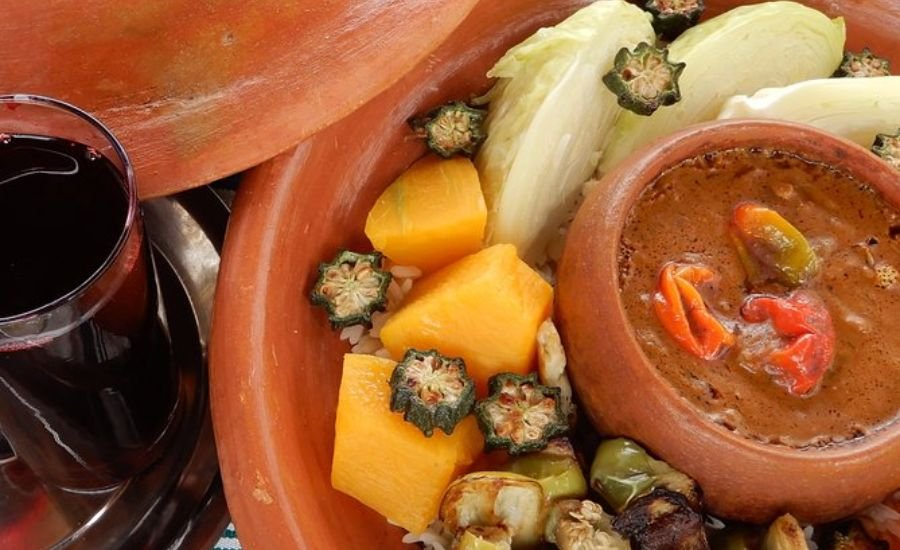Mali food reflects its culture in every detail. Found in West Africa, Mali boasts an expansive and historic past shaped by various ethnicities that contribute their culinary traditions to shaping Mali’s cuisine today. Agriculture provides ingredients like grains, vegetables, and meats from which Mali draws its culinary traditions – offering one of Africa’s richest cultures with mouthwatering dishes representing various ethnic groups within Mali! As one of Africa’s culturally rich regions, Mali cuisine showcases unique tastes, textures and cooking methods which reflect all these culturally rich ethnic groups present within Mali!
Mali cuisine reflects its agricultural roots; rice, millet, and sorghum are staple grains consumed frequently alongside delicious stews and soups made of tomatoes, onions, and okra. Mali’s cooking tradition has been handed down through generations; each region utilizes unique methods in preparation.
Traditional Ingredients in Mali Food
Mali cuisine centers around traditional ingredients grown locally. Millet and rice are staple grains used in dishes like peanut stew and served alongside meat dishes or stews as side dishes. Furthermore, another essential part of Malian food culture has long been its nutritional constituent known as Fonio (a small grain that has long been part of Malian culinary history).
Peanuts are also essential ingredients, often being utilized in sauces and stews prepared in Mali’s cuisine. A popular example is made – an exquisite peanut stew known to showcase Mali’s diverse culinary culture. Other commonly utilized ingredients in Malian meals are goat, chicken, and fish as well as vegetables such as spinach tomatoes, and eggplant – each contributing their unique flavors for unforgettable meals!
Mali’s Food: A Culinary Journey Across Africa
Malian cuisine transcends taste; its flavor is also steeped in tradition and storytelling. Drawing influence from neighboring Senegal and Mauritania as well as ancient trade routes, Mali’s Sahelian location means its cuisine shares similarities with those from North and West Africa.
Malians value communal dining experiences. From sauce d’arachide and hearty bowls of riz au gras (rice with meat and vegetables) to their signature sauce d’arabiachi dish, every dish in Mali’s cuisine tells its unique cultural tale.
Popular Malian Dishes
Must-Try Mali Africa Food Recipes
Mali Africa cuisine features many mouthwatering dishes that embody its vibrant cuisine culture, such as:
- Maafe: Peanut stew is an indulgent and flavorful dish featuring meat (usually goat or beef), vegetables, and peanuts for an indulgent family-style dinner option. When served alongside rice or couscous it makes an unforgettable family gathering meal!
- Tigadèguèna: Malians commonly serve this dish at celebratory events to mark a significant event or to welcome special guests. Its peanut sauce complements both rice and millet perfectly for this festive meal!
- Saka Saka: Malians delight in enjoying this dish made of cassava leaves paired with fish or meat and enjoyed throughout Mali, particularly the southern regions.
These dishes provide just a small sampling of Mali’s vibrant culinary scene. Mali cuisine’s beauty lies in its simple preparations with bold flavor accentuating ingredients native to its region.
Highlights of Mali’s Food Staples (Rice, Millet, and Fonio)
Rice, mille,t, and fonio are three staple ingredients found throughout Mali food culture that form the backbone of traditional meals. While rice serves as the basis for most traditional Mali meals (serving it alongside meat stews or vegetable-based sauces), millet typically gets ground into flour to create porridge or for bread-baking purposes.
Fonio, one of Mali’s most nutritious grains, can be found in traditional dishes like couscous and futon (a soft mashed dish), while its healthful benefits have gained global recognition. Plus, quick cooking times make Fonio an indispensable staple in Malian households.
Traditional Sauces and Sides in Mali Food
Mali cuisine’s hallmark sauce – maafe (peanut sauce) stands out among them all with its unparalleled depth of flavor, lending hearty stews an irresistibly delicious texture and depth of taste. Another famous peanut-based sauce called sauce d’arachide often pairs well with rice or couscous as well.
Vegetables such as tomatoes, onions, and okra are often featured as ingredients in stews and side dishes for their combination of taste and texture. Fried plantains or to (made of millet starch) often make excellent accompaniments that complete meals by rounding out flavors perfectly.
Exploring Regional Variations in Malian Cuisine

Northern Mali’s Food Specialties
Northern Mali boasts an exotic desert environment which influences its cuisine. Due to a shortage of water resources, people living here have developed methods of food preservation through drying meats and vegetables; drying meat-and-millet dishes is particularly beloved among its people, while hearty stews made with lamb, goat, or camel meat can also be enjoyed here.
Southern Mali’s Culinary Highlights
Mali’s southern regions are famed for their lush terrains and agricultural abundance, where local people rely heavily on grain crops, vegetables, and fruits grown nearby for sustenance. The cuisine here places fresh ingredients front and center; popular dishes here include saka saka and riz au gras.
Southern Mali cuisine tends to feature lighter dishes flavored with herbs and spices than its northern counterpart, offering greater aromatic depth than those served up for meals in northern Mali.
How Mali Thai Food Fusion is Evolving
Recently, Mali food and Thai cuisine have seen increased crossover. Thai street food influences can now be seen throughout Mali as restaurants and home cooks experiment with adding Thai spices, herbs, and cooking techniques into traditional Malian dishes for an innovative new twist that blends bold Thai flavors with familiar Malian ingredients.
Mali Thai Kitchen: A Blend of Cultures
Thai Street Food by Thai in Mali
Thai street food has made waves across Mali’s urban centers, serving dishes like Pad Thai and Tom Yum Soup alongside traditional Malian meals. This combination of cultures creates dishes which are both familiar yet exciting for locals – an evolving food scene is becoming a hallmark of Mali itself!
Fusion Dishes: Mali Food Meets Thai Spices
Mali food has begun experimenting with more innovative fusion dishes, like Maafe with the addition of Thai curry paste or Tigadeguena made with coconut milk and Thai basil. These innovative combinations bring the best from both worlds together for culinary discovery while simultaneously honoring Mali cuisine’s roots and traditions.
The Role of Thai Street Food in Mali Thai Kitchens
Thai street food in Mali has become an exciting trend of culinary experimentation. Ingredients commonly associated with Thai cooking such as lemongrass, kaffir lime leaves, and chili peppers have made an entrance in Mali kitchens for fresh yet vibrant meals. Thai street food offers both locals and visitors an exciting new taste experience of Mali!
The Cultural Significance of Malian Cuisine
Food in Malian Celebrations and Festivals
Malians place great value in food as part of celebrations and festivals, often sharing communal meals during holidays or family reunions, symbolizing solidarity and togetherness. Traditional dishes such as saka saka or maafe may even be prepared especially on such special days for all to share and bond over this delicious tradition!
The Connection Between Mali Africa Food and Community
Malian cuisine transcends mere consumption: it embodies community and culture. Sharing meals is integral to Malian life and meal times can bring people closer together – these communal aspects reflect Malian society’s strong bonds of fellowship and solidarity.
How to Experience Mali’s Food at Home

Traditional Malian Recipes to Try
For an authentic Malian food experience at home, there are various delicious dishes you should try out. Traditional dishes like Maafe (peanut stew), Tigadeguena (peanut sauce), and Foutou (mashed millet) provide deliciously authentic tastes of Malian cuisine and are easy to create in just 30 minutes!
Where to Find Mali Thai Food and Ingredients
Finding ingredients to experience Mali food combined with Thai flavors requires visiting specialty stores or online retailers, though Thai herbs, spices, and sauces have recently become more accessible in Mali’s larger cities, making this unique fusion even simpler to try out!
Modern Interpretations of Mali Food
As globalization spreads, traditional Malian food is being transformed by modern cuisine. Chefs are exploring innovative techniques for cooking Malian cuisine while still staying true to its roots – and are taking steps such as serving their masterpieces at global festivals!
Conclusion
Mali cuisine is an extraordinary reflection of its diverse cultural traditions and flavors, from staple grains and hearty stews to the exciting mix of Thai street food with Malian ingredients – it continues to expand and develop over time! No matter if you visit Mali directly or experience its cuisine from abroad – its vibrant flavors and communal nature will leave a lasting impression!
FAQs
1. What are the popular dishes in Mali?
Maafe (peanut stew), Tigadeguena (peanut sauce), and Saka Saka (cassava leaf stew) are among the many beloved African cuisines that can be found across Africa.
2. How is Mali food unique?
Mali cuisine features ingredients like millet, rice, and fonio with rich and tasty stews and sauces made of peanuts and fresh vegetables.
3. Can I try Mali food outside Mali?
Yes, Malian dishes can be found at African restaurants globally; while hybrid cuisine such as Mali Thai food has gained increasing recognition.
